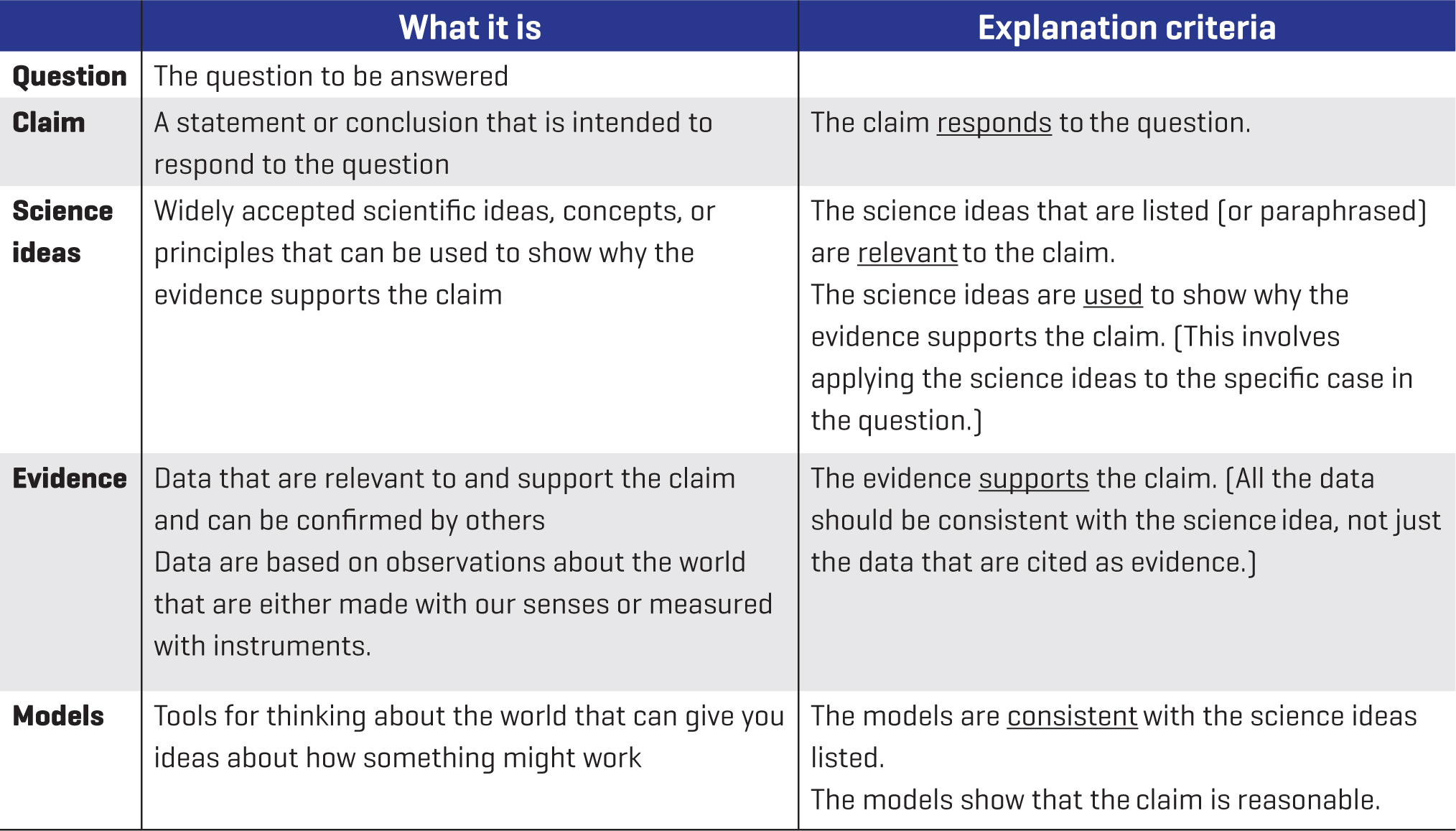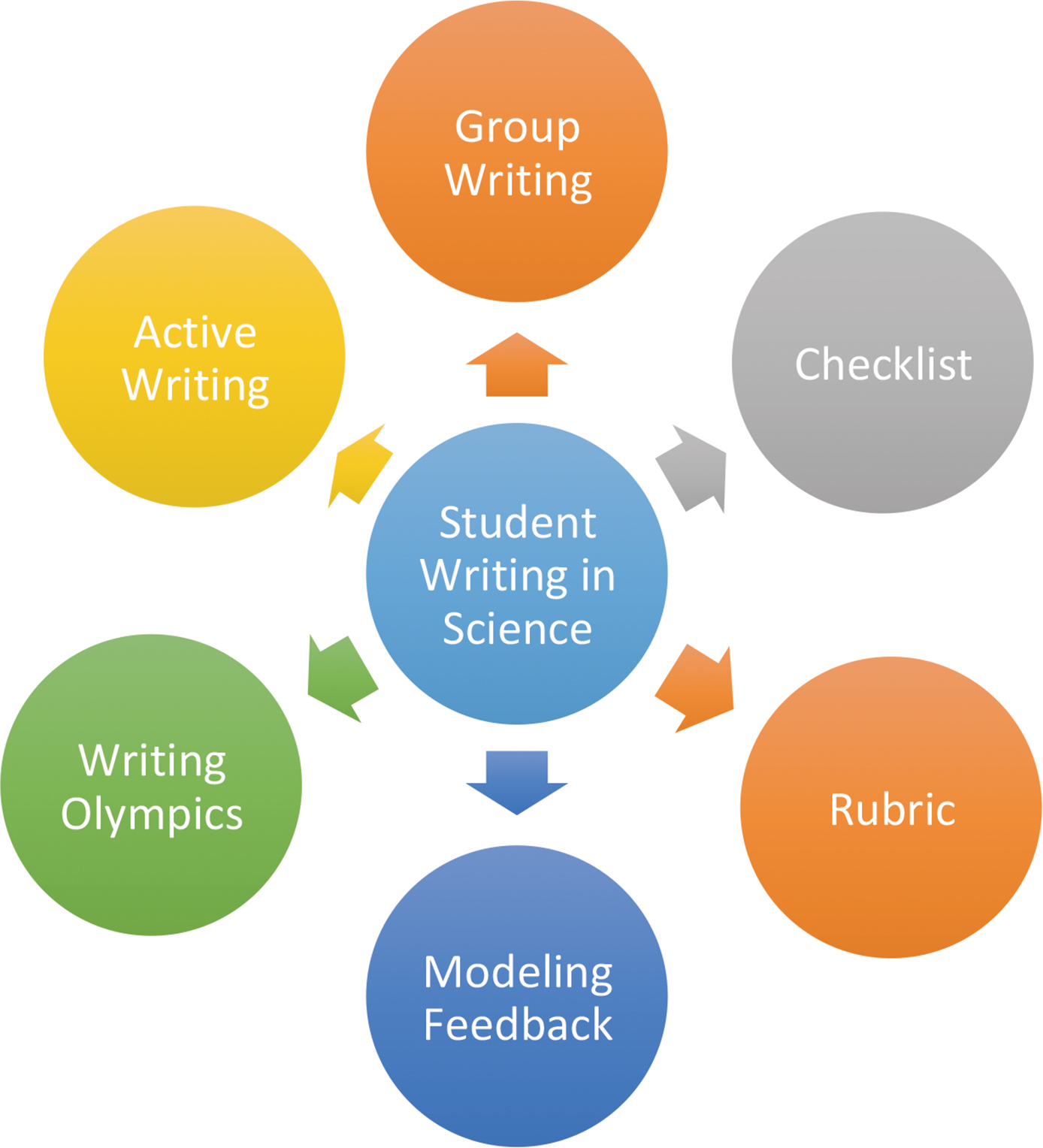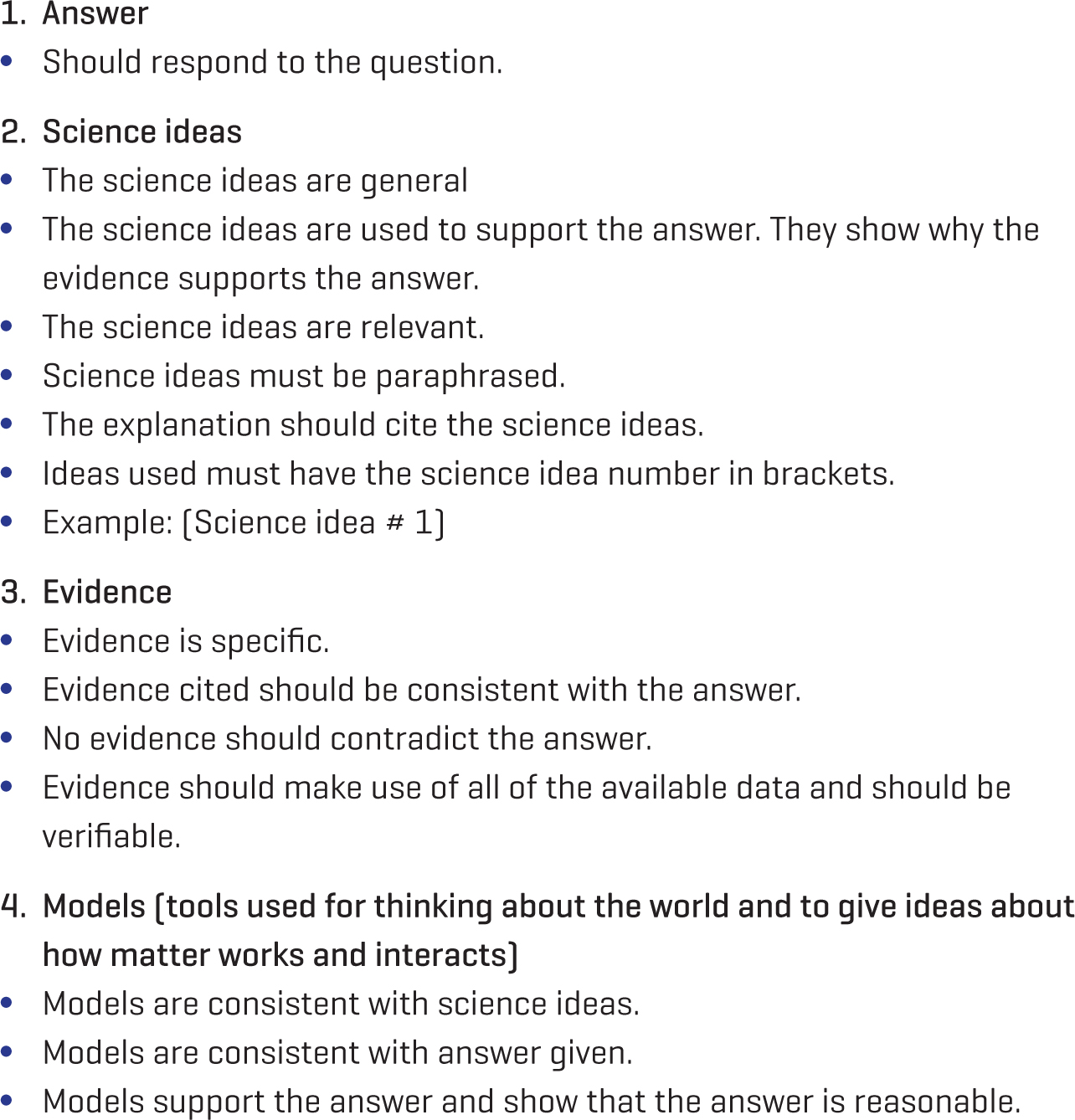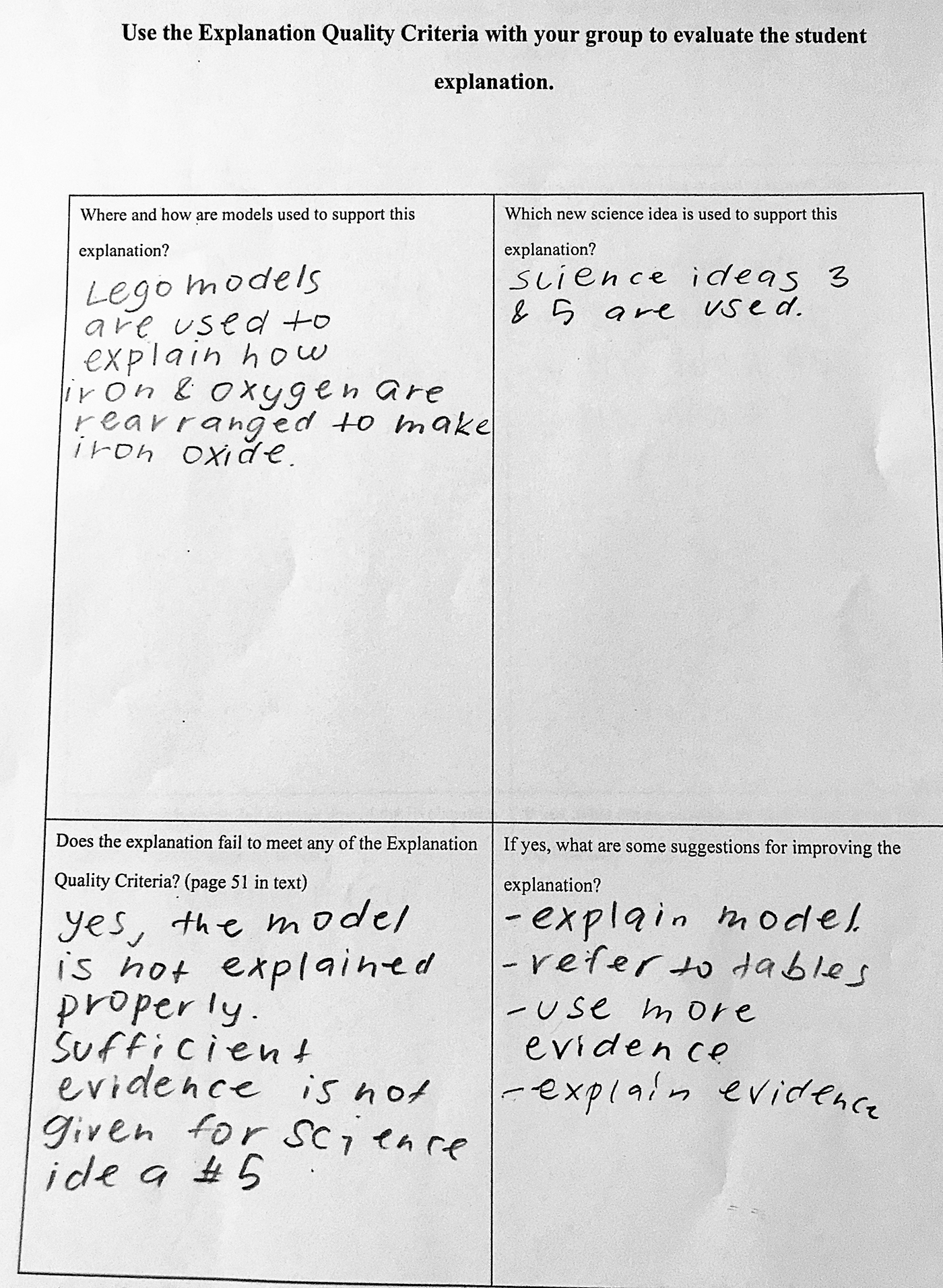Practical Research
Supporting Students In Writing Scientific Explanations
Science Scope—January 2020 (Volume 43, Issue 5)
By Mary Koppal, Meredith N. Long, Leah Donovan, Damisha Drakes, Sarah Q. Pappalardo, and Jo Ellen Roseman
Whether students are in history class or science class, and whether their final product is an essay or an oral presentation, constructing evidence-based explanations can be a daunting task for which they have had little preparation.
Over the past several years, a team of scientists, researchers, and educators has worked to develop a middle school curriculum unit (AAAS/Project 2061 2017) designed to help students investigate fundamental questions about the world. The development process involved more than 1,000 students and 12 teachers, and included multiple rounds of testing the unit in classrooms and multiple revisions based on student performance data, curriculum analysis, and feedback from teachers and expert reviewers.
The goal of the unit is to help students make sense of phenomena related to plant and animal growth using Next Generation Science Standards (NGSS) core ideas and crosscutting concepts about chemical reactions and matter conservation in physical and life science contexts and the science practices of data analysis, modeling, explanation, and communication (NGSS Lead States 2013). By the end of the unit, students are expected to be able to use ideas about the rearrangement and conservation of atoms to construct evidence-based explanations.
Each chapter of the unit includes an embedded assessment task that asks students to explain a phenomenon not encountered during instruction using the relevant science ideas they have learned; the evidence they have gathered through observations, experiments, or readings; and the models they have examined or constructed to support the claims in their explanations.
- Does your claim answer the question?
- Is your evidence relevant to your claim? Is your evidence convincing?
- Are the science ideas relevant to your claim? Is all of the evidence consistent with the science ideas?
The early lessons introduce students to an example of a valid explanation, define its essential elements, and provide an explanation template to help them organize their thinking and writing. The lessons also include a set of explanation quality criteria that students can use to judge the quality of their own or someone else’s explanation (see Figure 1).
By the end of the unit, students’ explanations are expected to reflect an increasingly sophisticated understanding of changes in matter during increasingly complex chemical reactions.

The role of classroom strategies and feedback
As development of the unit proceeded, it became clear that students were able to use the practices of data analysis and modeling to make sense of the initial phenomena, but they had great difficulty when asked to reason from evidence, science ideas, and models to explain new phenomena. Teachers in the study also found that most of their students were not enthusiastic about the writing process. When students were asked to explain an idea in writing, most of them took little time to organize their thoughts beforehand, and very few reviewed their writing before submitting it.
This article describes the supports for explanation writing that were provided in the unit and the strategies that teachers used in their classrooms to respond to the individual needs of their students. The supports provided in the unit were designed to address these difficulties, but for the supports to work as intended, teachers in the study were encouraged to give students immediate and very specific feedback on their writing. The strategies shown in Figure 2 provided a variety of ways to familiarize students with components of a valid explanation and with the process of constructing their own scientific explanations.

Strategies
Group writing
As a first step, many teachers used whole-class discussions to ensure that students understood and could apply the explanation quality criteria in the unit to evaluate and construct explanations. The criteria and ideal explanations were posted around the classroom. The class then identified and discussed the key elements of an explanation, how to support claims with evidence and science ideas, and how to make their reasoning clear to others.
Working together, the class constructed an explanation and discussed each other’s contributions to the process (e.g., “That was a piece of evidence I hadn’t thought about,” or “I’m not sure we’ve linked the evidence to our claim yet.”). Constructing the first explanation as a class encourages collaboration in learning and takes the pressure off individual students. To encourage participation, one teacher awarded her students with colored stickers for each of their contributions to the discussion. The stickers helped to establish student participation as a classroom norm at the beginning of the year and enabled both students and teachers to efficiently monitor participation as the year progressed. Students put the stickers in their workbooks, and these were later tallied for a grade.
Many teachers also assigned students to work as a team on the unit’s early explanation activities. This made the writing task less intimidating and helped anxious students get started on the writing process. After identifying the different elements of an explanation, students worked together to synthesize their data and identify the best pieces of evidence and the most relevant science ideas to support their claim. This approach encouraged collaboration and conversations among students and let them share responsibility as they gained more experience in dealing with all elements of a very complex and, for them, novel practice.
Explanation quality criteria
Teachers often used the explanation quality criteria and questions as a writing checklist to remind students of the key characteristics of a good explanation, to provide a more detailed description of each element in the unit’s explanation template and to clarify how each element supports the explanation (Figure 3). After writing an explanation as a whole class, team, or individual, the explanation was evaluated according to a rubric based on the checklist. The aim was to encourage students to become more mindful of what the purpose and expectations were for their writing task and to be more critical of their own writing before turning it in, something that had been emphasized in the district since elementary school.

Modeling feedback
Few students have experience in providing constructive feedback about explanation writing, and teachers realized they would need to model the process for students. In an early activity in the unit, one teacher led students in evaluating two different anonymous sample student explanations by applying the unit’s explanation quality criteria. After highlighting each element of the explanation with a different colored marker, students then used the writing checklist provided by their teachers to critique the quality of the writing in the sample explanations and suggest revisions. This gave students a sense not only of how to provide feedback, but also of what was expected of students when writing their own explanations.
Writing Olympics
This strategy was easily incorporated into group writing. Student teams rotated through the written explanations of the other team members using the writing checklist and a simplified version of the explanation quality criteria to analyze responses and “score” them (see Figures 3 and 4). Having a class conversation about the explanations gave students an opportunity to clarify what they were trying to convey in their explanations and to get feedback on what they had actually written. Students were expected to use their scores to revise their own explanations and to be able to summarize what they had done to improve their work.

Active writing
For this strategy, students first recorded on separate index cards a claim, a supporting piece of evidence, and relevant science ideas for their explanation. Students then worked with a partner or lab group to rearrange the cards until they came up with their best response. This gave students a kinesthetic means of writing and organizing the elements of an explanation into a first draft. Students who needed extra support started out with index cards on which the elements of an exemplar explanation were already written and then they organized the cards. This strategy also let students practice synthesizing and evaluating evidence drawn from multiple sources.
Outcomes
With the combination of the supports provided in the unit, the classroom strategies that teachers employed, and multiple opportunities to get feedback on their work, many students made considerable progress in constructing evidence-based explanations of phenomena.
The small-scale study of the unit also showed that explanations of students who used the study unit improved much more than those of students who had used the district unit. In addition to multiple-choice items, both pre- and posttests included two, two-tiered items that asked students to explain why the answer choice they selected was correct. Almost a third of students who used the study unit provided an explanation of the growth of moldy bread in a sealed baggie that connected appropriate evidence to science ideas about atom rearrangement and conservation. In contrast, only 1% of students who used the traditional district-provided unit performed at the same level (Herrmann-Abell, Koppal, and Roseman 2016).
Although teachers were pleased to see this empirical evidence of growth in their students’ writing abilities and understanding of the science, they were not surprised. Day by day, they had seen their students become more engaged during class and more confident in their new knowledge and skills.
After participating in the study, teachers say they are different too. While the teachers would never discount the extra time and effort it takes to participate in a research study, they would urge others to take advantage if they have the opportunity.
Literacy Teaching Strategies Middle School


